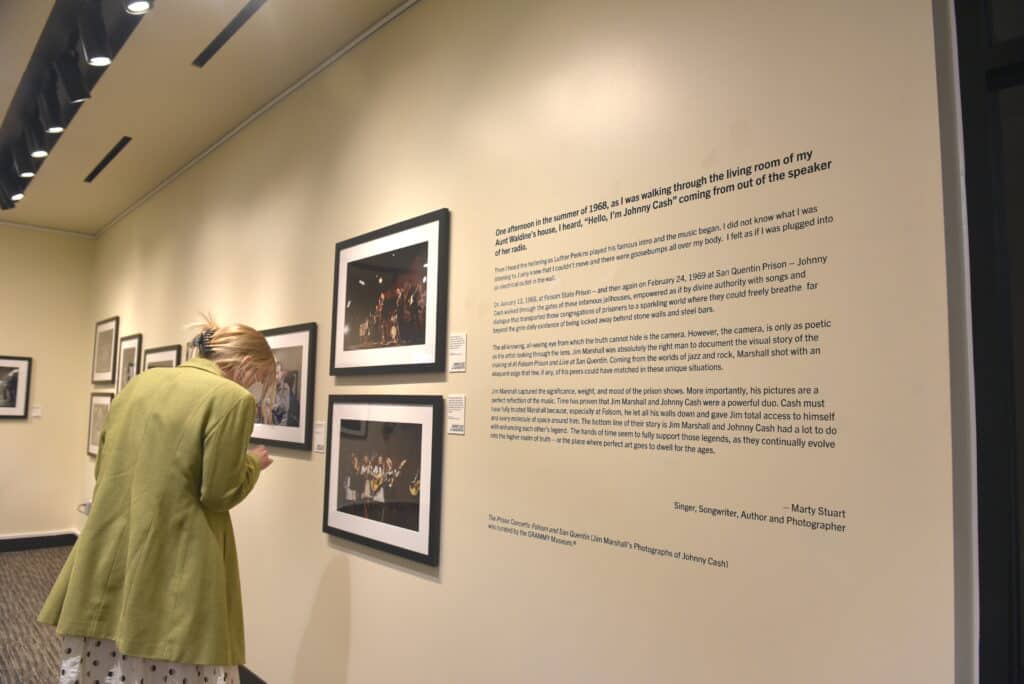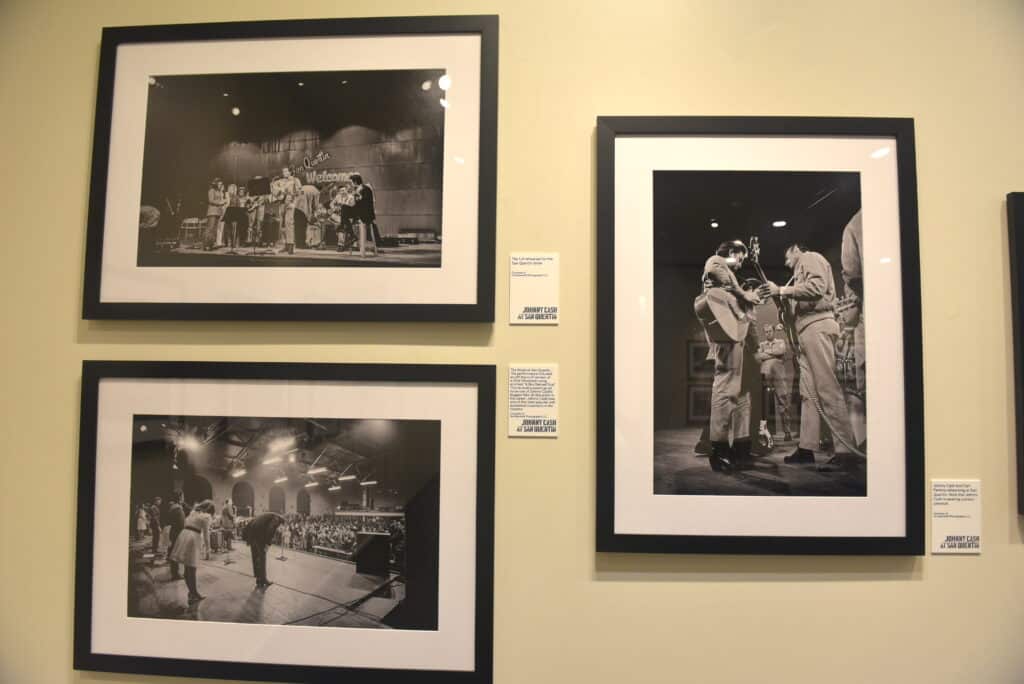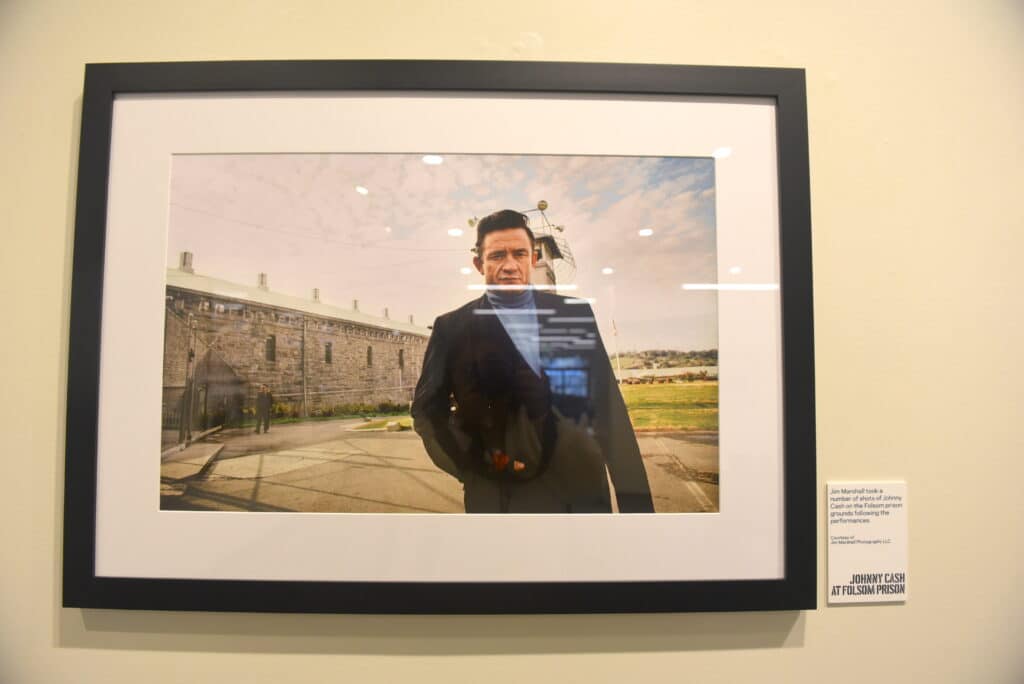
Presentations explored the topics of prison reform, the power of faith behind bars and its ability to change lives for the better
Faith, reconciliation, and flourishing.
A symposium on prison reform was held at Pepperdine University on Thursday, Jan. 12, as part of a Grammy Museum-sponsored exhibit on “Johnny Cash: At Folsom and San Quentin,” photographs by Jim Marshall of the legendary prison concerts in 1968 and 1969.
Singer/songwriter Marty Stuart has a dialogue displayed at the exhibit along with the photographs: “On January 13, 1968, at Folsom State Prison and then again on February 24, 1969, at San Quentin Prison, Johnny Cash walked through the gates of these infamous jailhouses, empowered as if by divine authority with songs and dialogue that transported those congregations of prisoners to a sparkling world where they could freely breathe far beyond the grim daily existence of being locked away behind stone walls and steel bars.

“Jim Marshall captured the significance, weight, and mood of the prison shows. More importantly, his pictures are a reflection of the music. Time has proven that Jim Marshall and Johnny Cash were a powerful duo. Cash must have fully trusted Marshall because, especially at Folsom, he let all his walls down and gave Jim total access to himself and every molecule of space around him. The bottom line of their story is Jim Marshall and Johnny Cash had a lot to do with enhancing each other’s legend. The hands of time seem to fully support those legends, as they continually evolve into the higher realm of truth or the place where perfect art goes to dwell for the ages.”
Pepperdine Dean of Libraries Mark S. Roosa welcomed the audience and introduced the speakers.



“As I hope you will find through today’s presenters, there is no shortage of testimonials, from the diverse array of perspectives, as to the power of faith behind bars and its ability to change lives for the better,” he said.
The speakers and individual presentation topics were: Dr. Byron Johnson, who presented “Hidden in Plain Sight: How Inmate Peer Ministry is Driving a Paradigm Shift within U.S. Prisons”; Dr. Andrew Johnson, who presented, “I Give My Soul: Offender-led Prison Churches in Rio de Janeiro”; Dr. Courtney Hook, for” ‘Prison Saved My Life’: How Incarcerated Women Navigate the Rehabilitation-Punishment Dialectic Behind Bars”; Chaplain Ronald Olivier who presented “27 Summers: From Incarceration 2 Restoration”; and author, journalist, and documentarian Marshall Terrill for “Johnny Cash: Sinner or Saint?”
Dr. Byron Johnson began the presentation with a list of research at Pepperdine that are bible-based programs that help rehabilitate prisoners and reduce recidivism.
“Johnny Cash is so relevant it’s kind of remarkable we’re still seeing him everywhere we turn,” Johnson said. “One of the things we want to do in this center is to not make just arguments, but provide evidence for people who are skeptical and we believe people should be skeptical.”
One book that Johnson referenced was “Faith, Service Leads to Rehabilitation and Freedom,” the effects of faith based ministry on identity transformation, desistance, and rehabilitation.
“In a world where depression and suicide and over doses and anxiety, are so common, you go into prison and you find people that have joy, and peace and who are flourishing,” Johnson said. “We can learn and we need to learn from those that are experiencing flourishing in the most unlikely places.”
Johnson ended his presentation with research and articles Pepperdine faculty have been producing on prison reform.
Dr. Andrew Johnson presented “I Give My Soul: Offender-led Prison Churches in Rio de Janeiro.” Johnson shared images of churches in prison and Johnny Cash’s song “If I Give my Soul.”
Dr. Courtney Hook, presented “‘Prison Saved My Life’: How Incarcerated Women Navigate the Rehabilitation-Punishment Dialectic Behind Bars,” and her research on rehabilitation. Hook said according to a research from 2018, 44 percent of individuals return to prison within the first year being released.
“What this tells me is that something’s not working. If nearly half of people are returning to prison, we need to really think through when we say words like rehabilitation,” Hook said. “I’m excited to be here because I get to bring a perspective of women behind bars, so although men represent 93 percent of the prison population, women are being arrested at an alarming rate.”
Hook said the number of incarcerated women increased 646 percent between 1980 and 2010. The rate of incarcerated women is growing at over twice the rate of men, more than two-thirds of female prisoners have experienced drug abuse and 6 to 10 percent of women are pregnant when they enter prison.
“We need to be gender responsive to the needs of incarcerated women,” Hook said.
Chaplain Ronald Olivier presented “27 Summers: From Incarceration 2 Restoration,” and shared his conviction experience in Louisiana.
“By the time I got to prison I was 18 years old, I was about 5’11, about 131 pounds, didn’t have one strain of hair on my face, looked about 11 years old, and I was thrown into this environment, to survive,” Olivier said. “I wish I could tell you I was tough and rough, but look at the retrospect, it was God’s grace — he protected me, he was there all the time, and I didn’t even know it.”
Olivier came home in November 2018 and is now the director of chaplaincy in the Mississippi Department of Corrections.
“I could tell you, there was light in the tunnel, that’s who I embraced, I embraced that light, and that light led me clean through that tunnel,” Olivier said. “God really did some things in my life while I was in prison. I’m grateful for what God did for me.”
Author, journalist, and documentarian Marshall Terrill for “Johnny Cash: Sinner or Saint?” shared the meanings behind Marshall’s images.
“His music and social activism gave light and hope to others,” Terrill said. “Johnny felt this compassion for these men and wanted to make a difference in their lives, visiting them in prison also has made a difference in his life.”
After the program, participants gathered at the library gallery to view the 23 photographs and shared their perspectives from each photograph.





Pepperdine Vice Chancellor and Global Engagement and Development Karin Shaw was familiar with Cash’s music but learned more about the meaning behind each photograph from the presentation.
“I absolutely loved it,” Shaw said. “I never stepped into a prison, but I feel like the speakers really opened a door and gave me a glimpse on how prison can turn into a place of hope, faithlessness can turn into faith, and punishment can turn into redemption. It was very moving.”

Shaw said her favorite image is where Cash is seen shaking Glen Sherley’s hand. Shirley was an inmate at Folsom Prison and wrote the song “Greystone Chapel.” As a surprise, Cash performed the song that day and Marshall took the photo after the performance.

“Normally you clap along but once you hear it was a witness story of someone who actually was in prison, I started to cry,” Shaw said. “Knowing the context, I couldn’t have gotten it without the program.”
“It makes me really want to learn more about him (Johnny Cash),” Shaw said. “He could also relate to them; he realized he messed up so much himself, he could be in their place, in a sense.”
The symposium was hosted by the Center for Faith and the Common Good and the gallery exhibit will be on display until April 9 at the Payson Library at Pepperdine.
